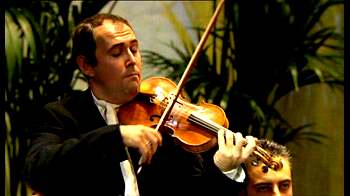Antonio Vivaldi was
one of the most virtuosic violinists
of his time. His own compositions for
the violin give a pretty good idea of
what he was capable of. It is no surprise
that most of his violin concertos were
never published: how many violinists
of his time - and ours! - would have
been able to play them? This disc offers
some brilliant specimens of his art
of composing for the violin. But the
programme is more than just a showcase
for virtuosity. Both Enrico Onofri and
Olivier Fourès, in their respective
programme notes, explain how Vivaldi
uses violin techniques to express certain
ideas. In particular Onofri demonstrates
how a detailed knowledge of the concepts
of rhetoric and 'affetti' helps to explain
why Vivaldi wrote his concertos in a
specific way. The titles of five of
the six concertos on this disc give
an indication about the ideas lying
behind them. The Concerto La Caccia,
for instance - which gives the disc
its title - strongly resembles the third
concerto - Autumn - from the
famous Four Seasons. This concerto
cannot be considered 'programme music'.
Unlike the Four Seasons it
doesn't contain a sonnet explaining
what the music is about. Onofri nevertheless
gives a fairly convincing idea of what
the concerto could express. He describes
in detail what he thinks Vivaldi is
trying to recount: the story of a hunt,
with the sound of horns, huntsmen galloping,
a fleeing animal, huntsmen taking refreshment
(adagio) and then the continuation of
the chase of the animal in the last
allegro, which ends with the death of
the prey.
Onofri also indicates
how Vivaldi uses both playing techniques
and contrasting subjects to illustrate
"two different mental attitudes" in
Il Sospetto (the suspicion).
"The first violins suggest the uncertainty
of someone who is plagued by suspicion,
while the seconds, with an insistent,
needing rhythm, evoke the worm that
gnaws at the mind and constantly nourishes
doubt".
The concertos L'inquietudine
(turmoil) and Il Riposo (rest)
are each other's opposites, as the titles
indicate. The repetition of rhythmic
elements in the former, expressing despair
and torment, strongly contrasts with
the latter where all instruments are
muted - and no harpsichord is involved
- in order to express sleep and dreams.
The longest and perhaps
best-known piece in the programme is
the first, the concerto Grosso Mogul.
The title is probably apocryphal. "The
present interpretation is based on the
hypothesis that the name refers to the
great empire of India governed by the
Muslim dynasty of Mughal princes", Onofri
writes. He sees Turkish and gypsy elements
in this concerto, the latter of which
were associated with oriental civilisations
in general. He also refers to the fact
that the gypsies were originally from
India. It is interesting to know that
this "spectacular, technically challenging
concerto" (Olivier Fourès), containing
the first known examples of violin cadenzas
in the history of music, was first played
in church. This gives an idea of how
much theatre and worship were interwoven
in the Italy of the early 18th century.
This disc is a good
example of how the personal observations
of the performer help to understand
not only the music but also the interpretative
choices he has made. And the playing
by Onofri gives a direct and concrete
illustration of what he writes about.
It seems there is no end to Onofri's
playing technique: he just plays brilliantly,
and one never gets the impression that
the amount of virtuosity of these concertos
causes him any problems. But he also
knows his way with tenderness and intimacy,
as his interpretation of the last concerto
Il Riposo shows. The orchestra
is performing throughout at the same
level, and that makes this disc a winner
in every respect.
Johan van Veen


